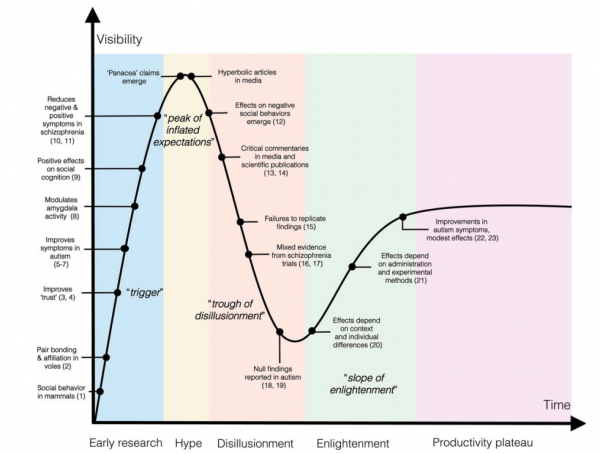
In a memorable stunt to kick off his 2011 TEDGlobal talk, neuroeconomist Paul Zak stepped onstage wielding a syringe filled with what he nicknamed “the moral molecule.” The clear liquid, which he then sprayed dramatically in the air, contained oxytocin, a hormone that was known to induce labor in pregnant women and stimulate the production of breast milk for the baby.
Zak promised the audience it could do much more. A spray of oxytocin up the nose, he said, could make people more trusting, more empathetic, and, therefore, more moral.
Zak was famous for a 2005 Nature paper that found that people who got a nasal blast of oxytocin became more trusting of others in a money-sharing game. Experiments that followed showed that a whiff of oxytocin could make people more willing to open up and share painful stories with strangers. They suggested oxytocin might improve theory of mind, or the understanding that other people have thoughts and intentions different from your own. And this led to the hope it could be helpful for some people with autism who struggle with theory of mind. (This line of research is still ongoing.)
Another study — incredibly — found that oxytocin made people more trusting of others, specifically when it came to guarding a document containing their sexual fantasies and habits. And, as Zak claimed in the TED talk, you don’t even need nasal spray. If you just hug another person eight times a day, he said, you can stoke oxytocin and “be happier, and the world will be a better place.” Finally, a cure for humanity’s sins.
New research, published February 8 in Nature Communications, underscores how narrow this “hug hormone” theory of oxytocin is. The study maps where in the brain oxytocin receptors reside, and the resulting atlas suggests this hormone is involved in regions in the brain correlated with appetite, experiencing rewards, and anticipation, as well as social relationships.
“This result makes it clearer to me that oxytocin is more of a regulatory hormone [i.e. a hormone that helps the body maintain its homeostasis] that happens to influence social behavior,” Daniel Quintana, a biological psychiatry researcher at the University of Oslo and the lead author of that study, tells me. “It tries to maintain stability in a changing environment.”
The myth of oxytocin as the “hug hormone” isn’t dead. You can still read new articles — especially around Valentine’s Day — on the internet about how being given chocolates or flowers boosts oxytocin, or how couples who work on art projects together can boost it as well (and presumably inject more empathy into their relationship).
The real story of oxytocin research reminds us — as many science stories do — that the truth is often more nuanced, and more wonderfully complicated, than it first appears.
Oxytocin is a poster child for hype in science
The early wave of exciting, hopeful findings about oxytocin came right before a crucial point in the history of psychological science. Around 2011, many psychologists began to realize, en masse, that some of their most common experiment methodologies were prone to producing false positives. And so, many scientists went back to test textbook theories with greater rigor. Many of those tests failed to produce the original results. This is sometimes referred to as psychology’s “replication crisis,” and it came for oxytocin research too.
When scientists revisited oxytocin experiments with new participants, they often couldn’t repeat the results. So researchers took a deeper look into the methodology of oxytocin research. “[M]ost of the reported positive findings regarding how OT [oxytocin] affects human behavior are likely to be false-positives,” a 2015 statistical overview of oxytocin research concluded.
It appeared the field suffered from underpowered studies (i.e. having too few participants in experiments) and publication bias, which is the tendency for positive findings to be accepted into academic journals and for negative findings to languish in a file drawer. Oxytocin’s “moral molecule” reputation was standing on a pile of science that was preliminary at best.
The doubts continued to pile up. Researchers realized the nasal sprays they used to deliver oxytocin may not always actually result in much of the chemical reaching the brain. What’s more, some research found that the hormone might even play a role in negative social emotions too, such as increasing feelings of envy and schadenfreude.
“People with a lot of interpersonal insecurities — whether they have prior experiences with negative relationship, or even in borderline personality disorder, where you have extreme concerns about being abandoned by others — in those individuals, oxytocin [may] amplify those interpersonal fears and concerns,” Jennifer Bartz, a McGill psychologist, told me in 2016.
These findings cut against the “hug hormone” hypothesis of oxytocin. But still, there was biology to be learned from studying oxytocin with greater rigor. And more modest conclusions emerged.

So what does oxytocin actually do?
Oxytocin is a real hormone, a neuropeptide, that has been shown to influence behavior across the animal kingdom, particularly in mammals, and particularly in social mammals. When scientists block oxytocin altogether in the brains of prairie voles — a rodent best known for its monogamy — they become uninterested in their mates. It does something to an animal’s brain.
“If you administer oxytocin to virgin rats, all of a sudden they begin acting like mothers, and they start collecting all the pups, building nests, and all these kinds of things,” Quintana says.
And though many scientists have made grand statements about oxytocin’s role in human relationships, scientists really didn’t understand exactly what it did in humans.
The latest Nature Communication paper shows it’s possibly doing much more than we thought. It provides the first whole-brain map of associations between oxytocin receptors and brain activity.
In the paper, Quintana and his co-authors matched up two datasets to create a map of where oxytocin receptors exist in the brain, and infer what behaviors they may play a role in. One dataset came from cadavers — brains donated by science that have been mapped in terms of gene expression (meaning mapped in terms of where genes that make certain proteins are turned on and off). Quintana used the database to find where genes for oxytocin receptors are turned on.
Then, he turned to another database of 14,000 fMRI studies that have mapped regions in the brain associated with different psychological states or behaviors. Lining up the two maps allowed Quintana to intuit — though not perfectly — what psychological states and behaviors the presence of oxytocin receptors are most strongly correlated to.
“We also got a lot of hits,” he says, including in regions involved with receiving monetary rewards, with anticipation, and in social connections. Behaviorally, oxytocin appears to draw our attention to personal relationships but doesn’t necessarily direct the emotions of them.
This work will need to be followed with more studies, so scientists can more strongly map the biology of oxytocin. Like so many findings in biology, the role oxytocin plays is likely to be extremely nuanced and complicated.
But that’s what our bodies and minds are: nuanced and complicated. And there are rarely miracle substances to make it all better.
Sourse: vox.com






